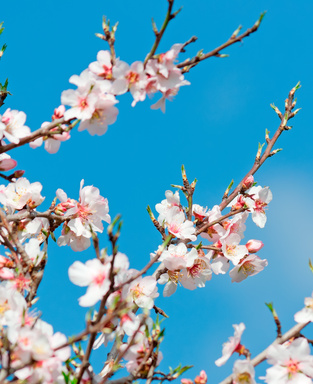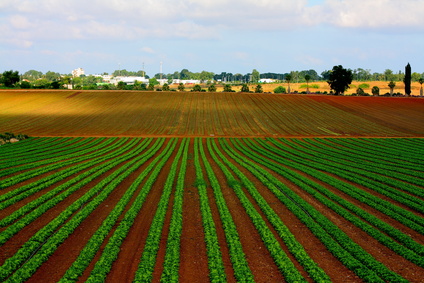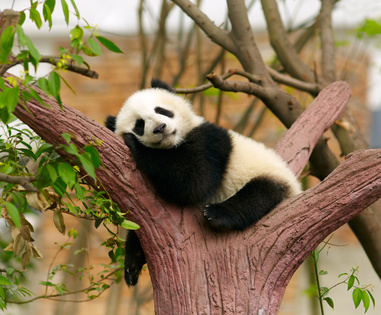Here is a perfectly lovely riddle of a chag for you :) …
It's yet another time to say "Happy New Year".
It's yet another time to say "Happy Birthday".
It falls in the middle of the eleventh month of the year.
Spring is doing its very first "sprung" (yes, we know we're talking about January/February).
It's yet another time of thanksgiving.
It's a deeply rooted holiday (pun intended) in both practical and spiritual senses.
In our long yearly list of festivals, at first glance Tu B'Shvat may look like a relatively quieter little chag off to the side. Yet when one thinks about it, its themes are so enormous and central. For our world would be nowhere without trees, plain and simple. They can do without us, but we quite literally cannot do without them.
Tu B'Shvat means 15th of [the month] of Shvat. This is a relatively more recent, abbreviated version of the name - previously the chag was more commonly known as Chamisha Asar B'Shvat (same meaning except for saying the actual Hebrew number instead of the numerical letters). It likely started out long ago as a localized early spring folk festival and demarcation point for the new agricultural year. While this is a Talmudically-mandated holiday, we certainly have a plethora of fruit and tree references running through the Bible. And as trees are such major creations and integral parts of our lives and welfare, they merit our serious attention and appreciation. So much so in fact, that Tu B'Shvat made it to a rather select list of new years.
 The almond tree, the first bloomer
The almond tree, the first bloomerIn Judaism, the rabbis laid out four new years as described in the Mishnah [Rosh Hashana 1:1]. The first of Nisan serves as a 'legal' new year- e.g. for counting the reign of Israelite kings, of months, and of festivals. Then we come to the first of Elul, the new year for the tithing of cattle. A month later we have the first of Tishrei - Rosh HaShana – which is designated as birthday for creation of the world, and specifically the new year for determining the religious numerical year, the reign of foreign kings, Sabbatical years (every seventh), Jubilee years (every 50th) and for some plantings, like of vegetables - in Israeli seasonal climate terms, this certainly makes sense.
This little beauty of a holiday - with the additional name "Rosh HaShana La-Ilanot" ["new year for the trees"] - is the fourth "new year" to cycle through our year (since remember - we count starting from the month of Nisan). It serves as designated birthday, thanksgiving day and judgment day (!) for fruit trees, and also more broadly as an Arbor Day. It is used as a cut-off date for determining the tithing of fruit; and in the world of nature, as the very first indication of spring generally and the new fruit-production cycle in particular - starting with that first bloomer, the almond tree. As to "judgment", this means which trees will survive another year and how well each will flourish. We might take this as a reminder of a divine hand in all aspects of creation and the delicacies involved in that complex, interrelated environmental feat. Whatever one's background or location, this is a chag whose foremost message speaks to everyone: one cannot take the trees of this planet - nor, more generally, the balances of nature's intricacies - lightly or for granted!
Again, keep in mind that Jewish festivals are based on seasonal, agricultural and climate conditions here in Israel. Before one concludes that such linkage makes these festivals less relevant, look at it from another perspective: Judaism's roots and attachment with Israel. Even if viewed from a perspective of nature issues more generally, we are this way provided with a constant common reference point and cultural language, no matter how dispersed we are through the world, no matter how disparate our various seasons, climes and individual experiences. Consider the "bokser" [Yiddish], or raw carob, traditionally handed out everywhere for this chag. This "charuv"- a delicious sweet treat which actually falls from its tree ready-to-eat in the fall - is a fruit which keeps well for fairly long periods. Thus began its long historical association with this chag, as charuv could travel the slow, far distances to Jews in the Diaspora – serving as a uniting taste of Israel everywhere in time for Tu B'Shvat. (It may not look so pretty or appealing like processed carob, but do try it – you may find it tastier. Ok, the author confesses to being a dedicated raw carob fan since early Hebrew school days, besides loving that so many tasty things grow on the trees all around her in this country).
 Agriculture in Israel
Agriculture in IsraelHaving a designated uniform birthdate for fruit trees also has some practical ramifications. According to Leviticus 19:23-25, you are forbidden to eat the fruit of a tree for its first three years after planting. Such a tree and its fruit are considered "orla" [literally, "uncircumcised"]. Then add one more year where all of the tree's fruit is to be "set aside for jubilation before the Lord". So actually you only start eating from your tree in the fifth year. For these purposes, a tree planted before the 15th of Shvat is considered a year older, even if planted only a day before the holiday. If planted any time after the chag date, it would be considered a year younger. (Since these are post-Temple times, there are some redemption mechanisms added too, with variations in different years. These aspects, together with where some rules apply, get slightly more involved- and are still practiced today by Orthodox Jews. You can ask your Rabbi about what is applicable and when, and we also refer you to this discussion on Wikipedia). What is especially noteworthy about this entire practice is the sensible idea that one should concentrate from the start more on careful nurturing and pruning instead of immediate benefits.
In more modern times, Tu B'Shvat is celebrated in Israel as a day of national reclamation and more. Planting a tree personally here, or funding such a planting from overseas - both for ecological purposes and to honor or memorialize someone - is now a common and wonderful practice. In this regard, Keren Kayemet LeIsrael (the Jewish National Fund) has been a well-known vehicle for planting millions of trees here. Come visit and see the tremendous results so far.
Did you notice the oddity that three new years start at the beginning of a month, yet this one falls on the 15th? The Talmud discusses a disagreement between the school of Shammai, which favored sticking to the first of the month, and the school of Hillel, which promoted the later date. The Shammai camp came more from the upper classes and conservative part of society. Hillel's base was linked more with the less-well-off but wider popular masses, thus recognizing the need for a more liberal attitude. This posited that a prosperous person could have better tended and watered trees that might start blooming earlier. Those who struggled more might need more time for their trees to recuperate from winter, and they'd also likely benefit from more of the still-ongoing rains so as to basically "get their act together". The Talmud chose to go with the more sensitive and populist position, thus halacha [law] follows the later Hillel date.
 Do you also feel a strong connection to trees?
Do you also feel a strong connection to trees?While Tu B'Shvat has notable practical and national aspects, it does not neglect a more spiritual side. This can be seen in the evolution of Tu B'Shvat seder practices, both older and more recent [see "Worthwhile Information & Tidbits", and "Let's Talk About It"]. For example, seder variants may look at characteristics of man through various types of fruit and/or trees. There is also the concept of personal enhancement and redemption by eating certain fruits in a proper and positive fashion, in contrast to that first taste of forbidden fruit in the Garden of Eden. We also reinforce our identity with Israel by eating fruits that the Holy Land is particularly celebrated for in the Bible (grapes, olives, dates, figs, pomegranates). In more recent times, not only Orthodox but also secular Israelis (and many schools and congregations all over) have embraced the idea of holding some sort of seder.
With heightened awareness of increasingly pressing ecological concerns the world over, this holiday has taken on this banner as well, making it more immediately relevant than ever. For Tu B'Shvat's central messages are such a perfect fit, and so very worth taking to heart - that our interaction with nature and God's creations should be one of respectful and nurturing forethought, together with a longer view of responsibility for the welfare of future generations [see also our "Let's Talk About It" section]. This mindset in turn also increases the blessings we may receive. And when we are cognizant and thoughtfully working for nature's betterment as part of tikun olam [improving our world], we are also bettering ourselves and showing proper appreciation for such gifts.
We at Learn Hebrew Pod wish you חג טו בשבט שמח /"chag Tu B'Shvat sameach" and a beautiful, delicious and promising fourth "new year".
